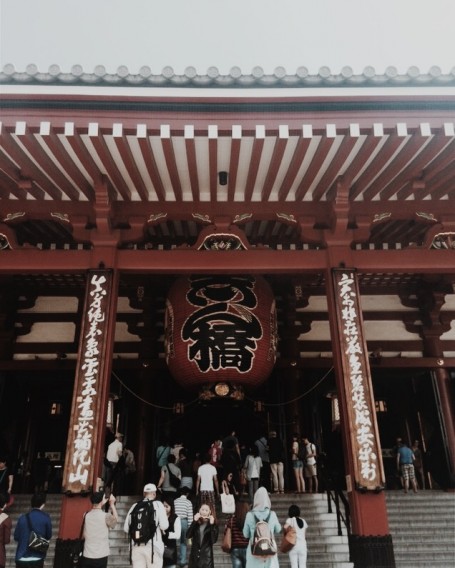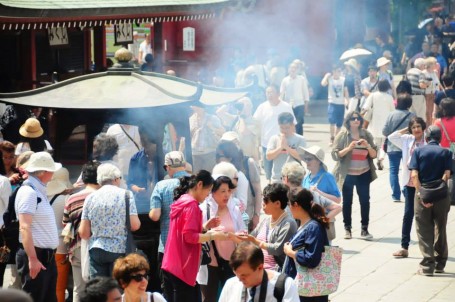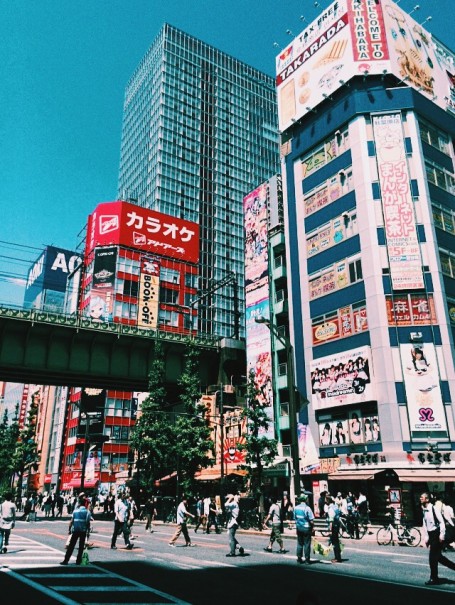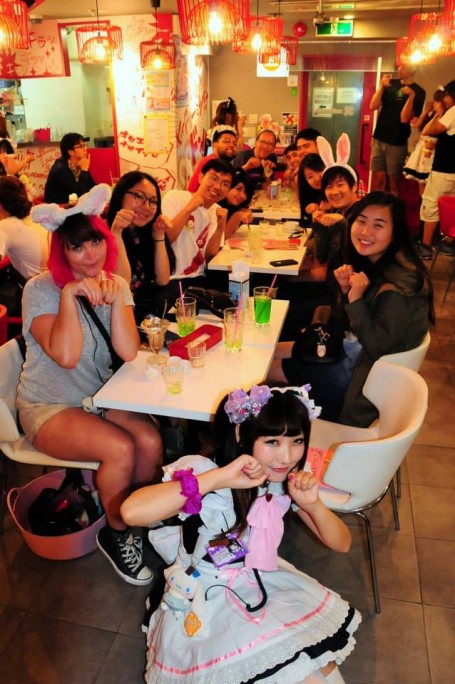By: Ye Sol Shin
On Sunday, May 31st, we visited the shrines of Asakusa as well as the busy streets of Akihabara. There was a stark contrast between the two locations, in terms of the buildings, people, and more. However, both Asakusa and Akihabara make up critical components of the foreign, or “western” perception of Japanese culture. Asakusa is a district in Tokyo that is considered an “old town” part of the city. We saw very elaborate and traditional temples, including the Sensoji temple, which is a very famous Buddhist temple built in the seventh century. Asakusa was swarmed with tourists, specifically foreign Asian tourists from China. We also walked down a famous street for shopping called Nakamise, which sold many traditional souvenir-type goods and Japanese snacks. Many tourists were popping in and out of the vendors’ stores throughout Nakamise, and buying things like traditional Japanese fans, katana swords, and good luck charms. It was amusing to see how at the food vendors stalls that sold small Japanese snacks, tourists were touching and grabbing at different snacks, even though there was clearly a sign that said “Please do not touch, the shopkeeper will attend to you.” However, even when the shopkeeper saw the tourists grabbing at the snacks, he did not show anger but rather politely asked them to stop doing so with a worried expression on his face. I felt like David Mura from his memoir Turning Japanese: Memoirs of a Sansei, in which he felt embarrassed for his wife when she was talking loudly in the subway train in Tokyo. Because I am a Korean American and can be easily associated as an Asian tourist visiting Japan; I felt almost ashamed to see other fellow tourists act rudely in front of Japanese shopkeepers. While we were in Asakusa, we saw a traditional Shinto wedding take place at one of the temples; it was so interesting to see this quiet, ceremonial ritual take place and then look outside the temple to see the hoards of people walking about and yelling at each other. To me, the Shinto wedding taking place in a hugely popular “touristy” attraction in Tokyo validates the fact that traditions and Japanese culture still prevails in a newly globalized Japan where technology and tourism play such an integral part of society. While the Japanese have embraced technology and tourism into their everyday lives, this does not mean that they have completely changed into a western society, or else the bride and groom would be wearing the traditional wedding dress and tuxedo, not traditional Japanese ceremonial clothing.
The traditional architecture in Asakusa was completely different from the tall buildings in Akihabara. The LED signs on the buildings of Akihabara were hard to turn away from – they were everywhere and all displayed different things, such as maid cafes, anime, and more. Akihabara was a colorful and chaotic jumble of people walking quickly around you. While the same sort of organized chaos existed in Asakusa, the difference was that most of the people at Akihabara looked like average Japanese locals. Akihabara may be a tourist attraction for foreigners, but it’s also a place for Japanese locals to hang out and shop. The goods that were sold at Akihabara were also completely different – instead of traditional Japanese souvenirs, Akihabara sold electronic merchandise at every corner. There was one particular electronic goods vendor that stuck out to me in Akihabara – there was a shopkeeper in front of his shop unloading batteries into a box in front of his shop. What was interesting was that people literally surrounded the shopkeeper and watched him unload the batteries, visually picking out which ones they wanted to buy after he was done. This kind of behavior was completely different from the behavior I saw from the tourists in Asakusa – each person was patiently waiting to buy a pack of batteries in an overcrowded street. At Akihabara, I was looking for things to purchase that I could “only buy from Japan,” such as small trinkets and souvenirs. Again, I felt a connection to David Mura, who also observed the “commercial mecca” (Mura Kindle 253) of Japan but did not feel a need to eagerly buy goods. Mura states, “the commercials on the TV screens, the ads in the magazines, on the billboards, were not designed for my desires or my American ego” (Mura Kindle 253). I felt exactly the same way. While everything looked fascinating, shiny, and new, I did not have any urge to purchase the goods and rather observed the Japanese consume around me. The maid café in Akihabara was also an entirely foreign experience for me and other USC students who went together. Again, while I found it fascinating to see Japanese locals come in and order elaborate parfaits and purchase services from maids dressed up in French maid costumes, I felt no desire to purchase the same goods or services. The 1,000 yen I gave up to go into the maid café wasn’t entirely a waste, but that one experience at the maid café was enough for a lifetime. While it is easy to think critically of the Japanese for liking and paying money for services that may seem to be derived from a fetish, my TA gave me an interesting explanation for why these types of services exist. Many Japanese “otaku” men who came to Tokyo from a smaller town or village may have never been able to share their love for anime with other people around them. The maid café was like a haven for these men who could enjoy the anime “maid” culture, interact with others who are interested in the same things, and overall have a fun time. Like Mura, I felt “disburdened” (Mura Kindle 253) by the fact that I don’t necessarily need to understand the totality of Japanese culture in order to immerse myself in the culture or have a fulfilling time.
In general, it was fascinating to see two entirely different parts of Tokyo. The Japanese really do a good job of integrating new into the old; even though it seems that the Japanese are obsessed with “new” and shiny things, that is not necessarily true. The consumer culture of Japan most definitely “attested to the Japanese fascination with newness” (Mura Kindle 253) and beautiful objects. However, the Japanese do not “equate beauty with frivolity” (Mura Kindle 253). The Japanese are eager and admire the fact that their country has invented and come up with beautiful and technological advanced products, but there is still an appreciation for the beauty of traditional rituals, such as the Shinto wedding that happened in Asakusa. Japanese consumerism can be portrayed as a successful capitalistic economy, but it also has deeply rooted cultural meanings that I plan on exploring more throughout the rest of the trip.




